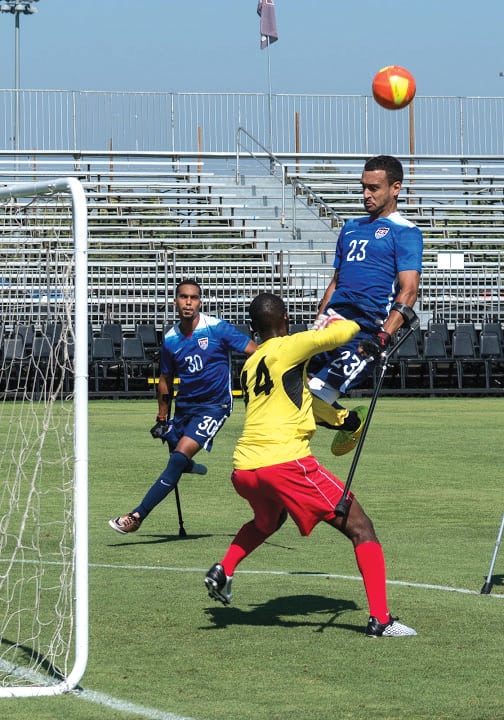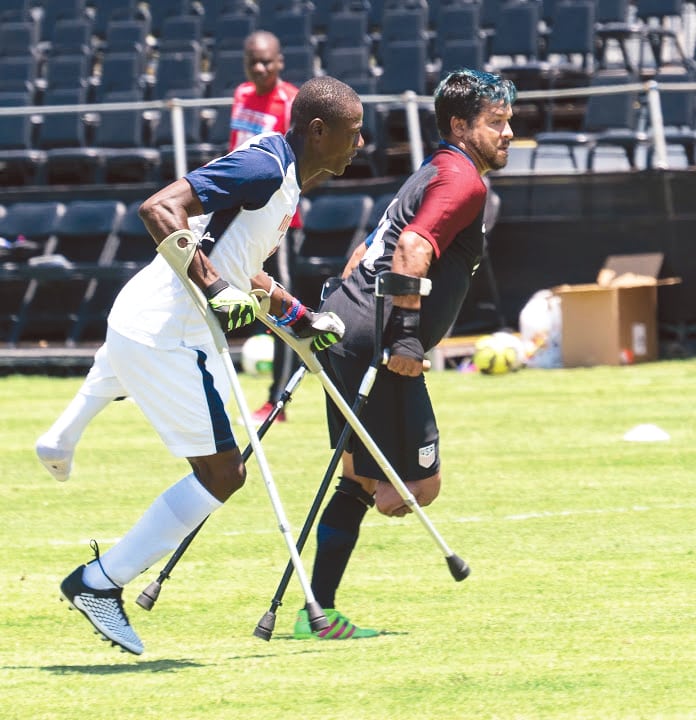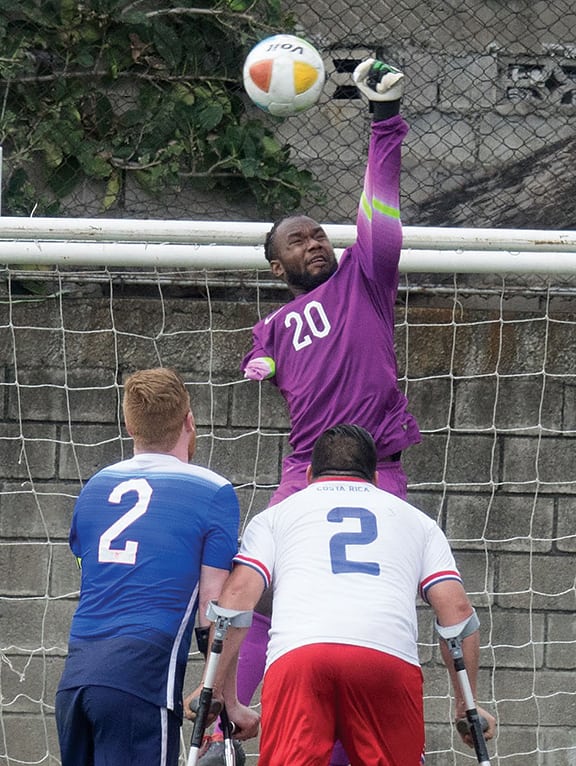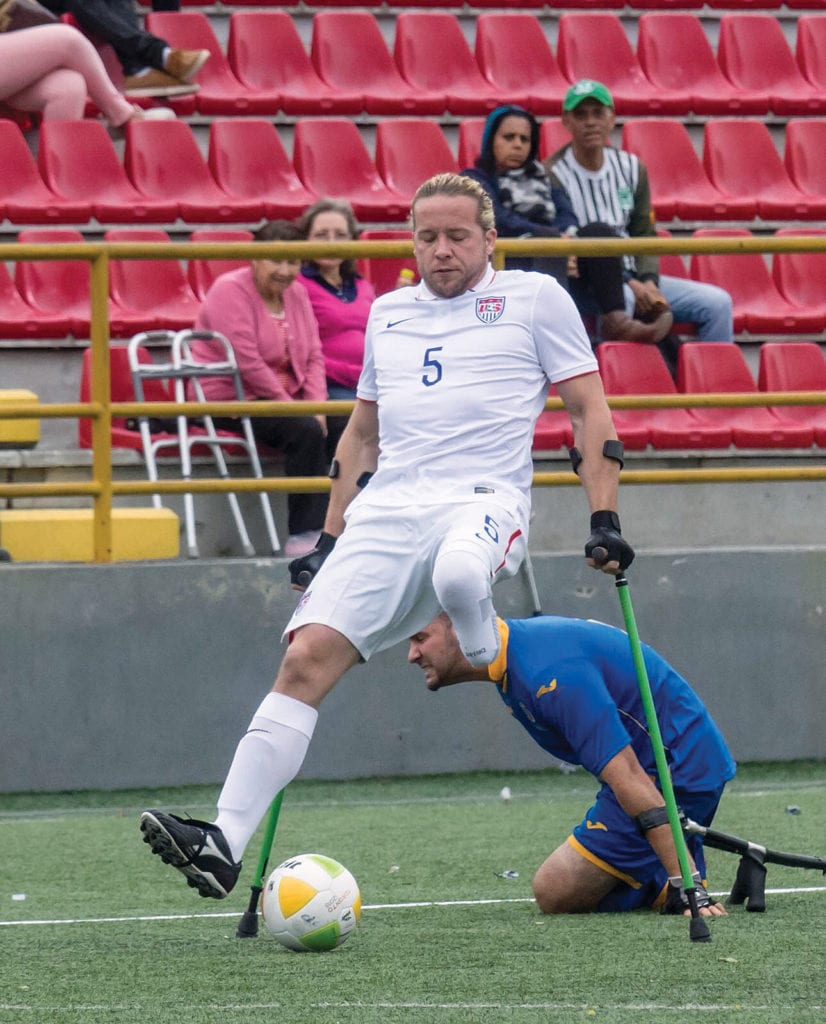“This sport means so much to me because it has a part of my life back that I had thought was taken from me forever.” — Robert Ferguson
Passion and Healing
Retired Army Sgt. Robert Ferguson has been passionate about soccer since he was 4 years old. He even played professionally for two years in the early 2000s for a minor-league team in Bundesliga, Germany, while serving in the U.S. Army. When a training accident in North Fort Hood, Texas, took his right leg below the knee in 2009, soccer was the last thing he was thinking about.
“After losing my leg, I couldn’t even watch soccer because of how much it hurt me emotionally,” recalls Ferguson—until two summers ago when the 36-year-old was introduced to amputee soccer.
“I have been actively training and playing this version of soccer since July 2016. When I found out about the sport, I was overweight and not in a great place mentally,” he says. “My experience as a player has been a challenging one. It is much harder than I ever remember soccer being. It is also more rewarding to be able to play again.”
Within a year after being recruited by Team USA Paralympic soccer goalie Keith Johnson, Ferguson, of Conroe, Texas, became regional developmental officer for the American Amputee Soccer Association (AASA) for the southern United States. He also founded the Lonestar Amputee Soccer Association in Houston and is captain of the Lonestar Houston soccer team.

He and teammate Craig Till are recruiting new players in Texas. Amputee soccer players must be single-limb amputees; to play for the national team, players must be at least 16.
Like Ferguson, 37-year-old Till grew up on a soccer field. Born with a bone disease that caused his left leg to grow improperly, Till faced numerous surgeries before he decided to have his left leg amputated below the knee when he was 16. Afterward, life resumed as normal.
Till, from Cedar Hill, Texas, says he came upon amputee soccer by accident at a time in his life when he needed it.

“I went down to San Antonio in February of 2014 to observe open tryouts for Team USA. They had extra forearm crutches, so I put them on and went onto the field to play,” he says.
Till, who has a 6-foot-1-inch frame, weighed 243 pounds and says he wasn’t in a great place mentally. The coach, however, was impressed with his athletic ability and skills and invited him to the next tryout.
“Over the next nine months, I trained at least six times a week, watched my diet, and worked my way down to 184 pounds. I made the team and represented the U.S. in the Amputee Soccer World Cup in Culiacán, Mexico, that December. We went into the tournament unranked. Many of us were rookies, young and inexperienced. We left ranked 12th in the world [of 32 teams]. To say we were all proud would be an understatement.”
Till adds that representing his country and walking in the opening ceremony of that 2014 tournament was inspirational for him, as was winning the bronze medal last summer in the Copa Americas International Tournament in Costa Rica—the first time in 35 years the U.S. medaled in the sport.
While the camaraderie and increasing success make the players’ commitment and resolve even stronger, they still face many challenges. Being spread out across the country means they rarely get to practice together. When they do, the training camps are intense.

Training and Commitment
“We do everything that able-bodied soccer camps do,” says Ferguson. “Passing drills, shooting drills, agility training, and lots of running. That is made more difficult simply because we are running on crutches. We are not allowed to wear prosthetics. Not only are we competing at elite levels, but we are doing it with huge impediments.”
Ferguson adds that the season is “whenever we can find a match that everyone can afford to go to.” And that’s not so simple because without sponsorship, players pay their own way for travel, lodging, meal expenses, and the right to represent their country in international or local matches.
The team has qualified for the 2018 Amputee Soccer World Cup in Guadalajara, Mexico, in October and will play in other upcoming matches.
For more information on amputee soccer, visit www.ampsoccer.org.

My experience as a player has been a challenging one. It is much harder than I ever remember soccer being. It is also more rewarding to be able to play again.” — Robert Ferguson

According to Hofmann explains that the international game is 6v6 + keeper. “We believe that everyone who wants to play should be allowed to play, even in geographical areas that can’t support full teams, so we also recognize smaller teams for development and recreational play.”to Rick Hofmann, president of the American Amputee Soccer Association, “The rules are as close to traditional FIFA rules as possible, with adaptations suited to the physical configurations of the players.”
Here’s what you need to know about the game:
- The pitch is about half the size as FIFA regulation.
- Outfielders must be abbreviated at or above the ankle;
goalkeepers may have two legs but must be abbreviated
at or above the wrist. - The game must be played on forearm crutches; no prostheses are allowed on the playing field.
- There are kick-ins in lieu of throw-ins.
- The ball may not be controlled or advanced with the crutch, and the residual limb may not be used to control or direct the ball.
- The off-sides rule has been waived.
- Unlimited substitutions are allowed.
- For safety, any offensive use of the crutch, such as slashing, tripping, or high sticking will result in an immediate red card and game ejection.



